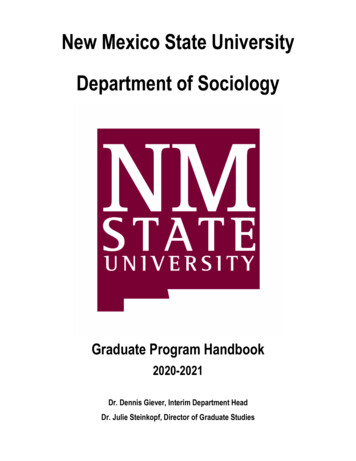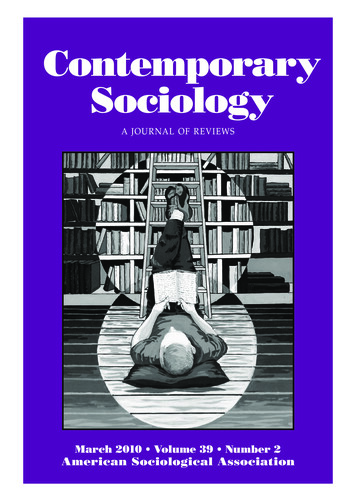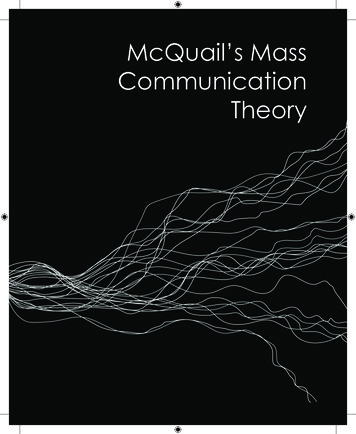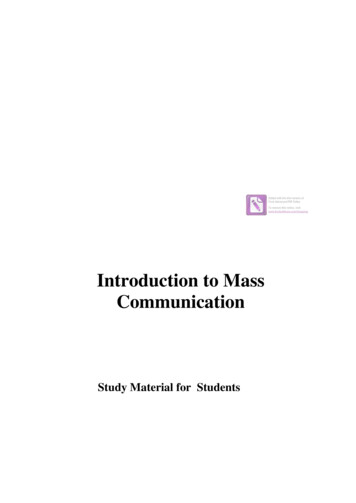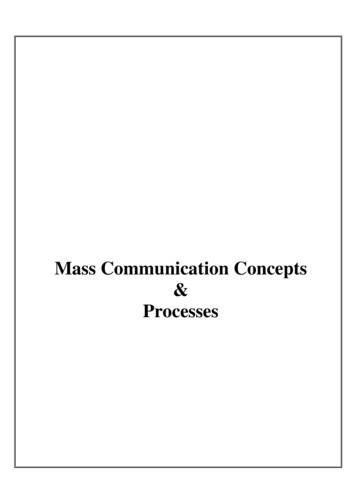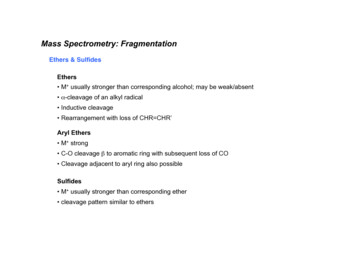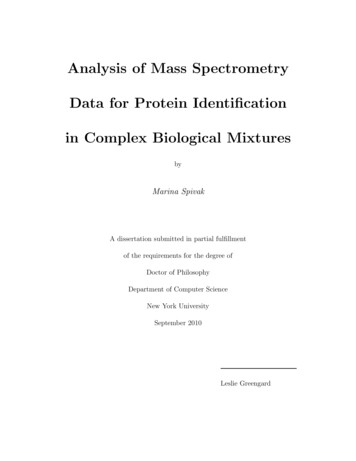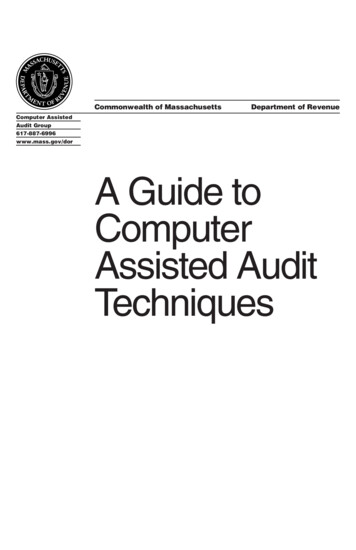
Transcription
MASS MEDIA & SOCIETY(SOCIOLOGY OF MASS COMMUNICATION)VI SEMESTERCORE COURSEBA SOCIOLOGY(2011 Admission)UNIVERSITY OF CALICUTSCHOOL OF DISTANCE EDUCATIONCALICUT UNIVERSITY P.O., MALAPPURAM, KERALA, INDIA – 673 635287
SCHOOL OF DISTANCE EDUCATIONUNIVERSITY OF CALICUTSCHOOL OF DISTANCE EDUCATIONSTUDY MATERIALCore CourseBA SOCIOLOGYVI SEMESTERMASS MEDIA & SOCIETY (SOCIOLOGY OF MASS COMMUNICATION)PREPARED BY:SCRUTINIZED BY:LAYOUT :Smt. RAKHI .N.,ASSISTANT PROFESSOR,DEPARTMENT OF SOCIOLOGY,ZAMORINS GURUVAYURAPPAN COLLEGE,CALICUTDR. N.P. HAFIZ MOHAMAD,‘MANASAM’,HARITHAPURAM,CHEVAYUR, KOZHIKODE.COMPUTER SECTION, SDE ReservedMASS MEDIA & SOCIETY (SOCIOLOGY OF MASS COMMUNICATION)Page 2
SCHOOL OF DISTANCE EDUCATIONCONTENTPAGEMODULE 1: COMMUNICATION5-8MODULE 2: MASS MEDIA9 - 16MODULE 3: THEORIES OF MASS MEDIA17 - 24MODULE 4: CULTURAL STUDIES, POPULAR CULTURE25 - 30MASS MEDIA & SOCIETY (SOCIOLOGY OF MASS COMMUNICATION)Page 3
SCHOOL OF DISTANCE EDUCATIONMASS MEDIA & SOCIETY (SOCIOLOGY OF MASS COMMUNICATION)Page 4
SCHOOL OF DISTANCE EDUCATIONMODULE 1COMMUNICATIONDEFINITION AND MEANING AND OF COMMUNICATIONThe word ‘communication’ is derived from the Latin verb communicare, which means "toshare" or "to make common". It may be explained as the meaningful exchange of ideas orinformation. Communication is the giving and receiving of messages from one or more people toone or more other people.Communication is a process whereby information is is channeled and imparted by a senderto a receiver via some medium. The receiver then decodes the message and gives the sender afeedback. All forms of communication require a sender, a message, and a recipient.Communication is thus a process by which meaning is assigned and conveyed in an attempt tocreate shared understanding.Communication may be defined as a social interaction through messages. It may be definedas the process of transmitting information and common understanding from one person to another.Communication is defined as “the activity associated with distributing or exchanginginformation”Another definition of communication describes it as “the exchange of thoughts, messages,or information”In a simple model or standard view of communication, information or content is sent insome form from the sender to the receiver. This common conception of communication simplyviews communication as a means of sending and receiving information. This model is based on thefollowing elements:1. A source of information which produces a message.2. A transmitter, who encodes the message3. A channel which transmits the message4. A receiver who decodes the messageTwo common elements in every communication exchange are the sender and the receiver.The sender initiates the communication. The receiver is the individual to whom the message is sent.The sender encodes the idea by selecting words, symbols, or gestures with which to compose amessage. The message is the outcome of the encoding, which takes the form of verbal, nonverbal,or written language. The message is sent through a medium or channel, which is the carrier of thecommunication. The receiver decodes the received message into meaningful information. Noise isanything that distorts the message. Finally, feedback occurs when the receiver responds to thesender's message and returns the message to the sender. Feedback allows the sender to determinewhether the message has been received and understood. Group and Mass CommunicationMASS MEDIA & SOCIETY (SOCIOLOGY OF MASS COMMUNICATION)Page 5
SCHOOL OF DISTANCE EDUCATIONGroup communication refers to communication between 3 or more individuals. Peoplebelong to groups to satisfy needs that they cannot meet satisfy on their own. By coming togetherwith others, the knowledge and experience to make decisions is pooled which helps accomplishtasks more efficiently than when done individually.Groups function by communicating ideas. An effective group is one that reaches itsconclusions after considering the widest range of ideas. For the group to fulfill its potential, all themembers need to feel comfortable in communicating their ideas, and must feel a responsibility tocontribute to the group discussion. If all members are not participating, some of the advantages ofgroup action are lost.Both the leaders and members influence the degree of participation among group members.By increasing participation, not only will the group do a better job of accomplishing its goals, but itis more likely to satisfy individual member goals. The more we believe the group capable ofmeeting our needs, the more attractive it will be to us, and the more likely we are to increase ourfuture participation. Both the members and the group as a whole will benefit from improved groupcommunication.Group size is one factor which influences group communication. The optimum size for agroup depends on the nature of its task. On one hand, there should be enough members to providediversity of interest. But, if the group becomes too large, participation will be affected. As groupmembers are added, the potential for new combinations of ideas increases significantly. However,as the size increases, it affects the effectivity of group communication.Another factor which influences group communication is physical arrangement. Studiesshow that interpersonal communication is enhanced by comfortable surroundings. Where peoplesit also has an influence on how they interact. Member status and eye contact are keyconsiderations in seating arrangements. Where a person sits indicates his or her status in the group.Those who sit at the head of rectangular tables are most often chosen for leadership. People talkmuch more freely if they have eye contact with other members. Those who sit at the corners oftables have the least eye contact and tend to contribute the least.Mass communication is the study of how individuals and entities transmit informationthrough mass media to large segments of the population at the same time. It is usually related tonewspaper, magazine, books, radio, television film etc as these media are used to propagateinformation, news and advertising. Mass communication is "the process by which a person, groupof people, or large organization creates a message and transmits it through some type of medium toa large, anonymous, heterogeneous audience." Mass communication is characterized by thetransmission of complex messages to large and diverse audiences, using sophisticated technologyof communication.EXTRA PERSONAL COMMUNICATIONExtra Personal Communication is that way of communication in which a human interactswith other species. Communication between human beings and non-human entities is extra personalcommunication.COMMUNICATION AND MODERN TECHNOLOGYNew communications and information technologies have created a global revolution inpatterns of communication and society. Modern communication technology makes it possible tostay connected anywhere, all the time, and the flow of information is nearly limitless. Along withall the benefits, however, come potential consequences. The ever increasing flow of informationMASS MEDIA & SOCIETY (SOCIOLOGY OF MASS COMMUNICATION)Page 6
SCHOOL OF DISTANCE EDUCATIONthrough our computers, televisions, and phones has its own advantages. But it also has a negativeimpact on the way we communicate and interactIn the present world communication plays key role in all the development activities fromeconomy to all relations in national & international activities. The development in moderncommunication has brought new era in the development of the world. In this aspect the advantagesof the communication is remarkable and can be seen everywhere from the world. Today we benefitmuch from communication. There are many benefits of the modern communication to our lives inall the fields. Earlier, there were no telephones, fax machines, internet, TV or any other presentresources of communication. Present communication has made the world a global village. Thismeans today the world is such a small place for which through communication we can know whatgoing on anywhere in the world. Television helps us to get breaking news from all over the world.The internet had given a boost to our daily communication. We can talk any one from anywhere inthe world through internet or phone. Even in the aspects of education one can get all theinformation requires from internet. One can even study from the internet through distance learningprograms.Communication makes us feel that the world is at our finger tips. Modern communicationhas brought a revolution to our present lives from education to medicine. Today we are using theadvance communication equipments to educate our children from computers facilities like internetto projectors. Modern communication has brought new era in the development of medical care. Inthe present many countries in the world is using the internet medical care including it through theinternet in some major operations also. In the future we will get more benefit from the moderncommunication since it will develop day by day, thus bringing more development to our world inall the areas.The development of the electric telegraph in the 1840s and the telephone in the late 1870smade rapid long-distance communications possible. Both media began in local areas and thenrapidly spread to connect large parts of the world. The telegraph and, to a greater degree,the telephone continued to be the principal media for telecommunications for most of the 20thCentury. The invention of radio at the turn of the 20th Century greatly increased the mobility ofofficial and personal communications and made greater volumes of com- munications possible.Radio quickly emerged as both a medium for point-to-point (e.g., ship-to--shore) and point-tomultipoint telecommunications (e.g., police dispatch) and a mass medium for information,entertainment, and commerce. The utility and consequent worldwide adoption and rapid evolutionof these new communications media prompted the creation of new legal and regulatory regimesboth internationally and domestically to set rates, standardize terms of service, and allocatefrequency bands to radio services by country. Innovation in electronic communications continuedto progress during the 1940s by the invention of television was later followed by computers,internet and mobile phones. All the emerging technologies are found to have an impact on thesociety.Modern technology has improved multiculturalism and the communication betweencultures. With modern communication technology such as TVs and phones, we can see what peopleat the other end of the world are doing. This will greatly help us understand the cultural diversity ofthis world, and we will learn to appreciate the cultural difference of people from different part ofthe earth. Modern technology increases the communication between cultures. By communication,one culture can learn from other culture and evolve. Modern technology helps us to preserve ourcultural relics and world treasures, and discover our culture in the past. We can also explore anddiscover more about our past, and have a better understanding of now and the future.MASS MEDIA & SOCIETY (SOCIOLOGY OF MASS COMMUNICATION)Page 7
SCHOOL OF DISTANCE EDUCATIONThe more advanced technology becomes, the more it seems to have control over our lives.Recent developments in technology such as the internet also led to a decline in “normal” socialbehaviors. With the advancement in latest technology, we have to face many disadvantages out ofthe benefit of modern technology such as a stress factor, hectic life, cyber crime and healthproblems. As we all know that we have entered an era of new and modern technology world that isequipped with super technology software through which we can work without employing personpower. On the other side, a new technology invented by the scientists has armed them with atechnology that can destroy a city in seconds with mere pushing a button. Similarly, the advancetechnology has created increasing incidents of cyber crimes.Social Isolation is on the increase, people are spending more time playing video games,learning how to use new modern technologies, using social networks and they neglect their real life.Technology has replaced our old way of interacting. Modern technology has replaced manyhumans; robots are doing of the jobs which used to be done by humans. Increased dependency onmodern tools like calculators has reduced on our creativity. Modern technology has been the mainaid in the increasing and endless wars. It aids the manufacturing of modern war weapons which willrequire testing. So when these weapons get into the hands of criminals, they will use them for theirselfish reasons.But despite knowing the side effects of these technologies, we are now making ourselvesfully dependent on it. Technology has influenced our lives to such an extent that we cannot livewithout its support though fully recognizing its negative effects.MASS MEDIA & SOCIETY (SOCIOLOGY OF MASS COMMUNICATION)Page 8
SCHOOL OF DISTANCE EDUCATIONMODULE IIMASS MEDIANATURE, CHARACTERISTICS AND FUNCTIONS OF MASS MEDIAMass media refers to the institutions that provide such messages: newspapers, magazines,television, radio, film and multimedia Web sites. The term also is used for the specific institutionsof mass media, such as radio networks and television stations, movie companies, music producers,and the Internet. Mass communication is characterized by the transmission of complex messages tolarge and diverse audiences, using sophisticated technology of communication.Some of the important characteristics of mass media are discussed below. The source of mass communication message generally is a person or groupoperating within anorganizational setting. Examples of these sources are newsreporters, television producers and magazine editors. Likewise, the source generallyis a multiple entity, and the resulting messag
MODULE 2: MASS MEDIA 9 -16 MODULE 3: THEORIES OF MASS MEDIA 17 -24 MODULE 4: CULTURAL STUDIES, POPULAR CULTURE 25 -30. SCHOOL OF DISTANCE EDUCATION MASS MEDIA & SOCIETY (SOCIOLOGY OF MASS COMMUNICATION) Page 4. SCHOOL OF DISTANCE EDUCATION MASS MEDIA & SOCIETY (SOCIOLOGY OF MASS COMMUNICATION) Page 5 MODULE 1 COMMUNICATION DEFINITION AND MEANING AND OF COMMUNICATION The word ‘communication .
